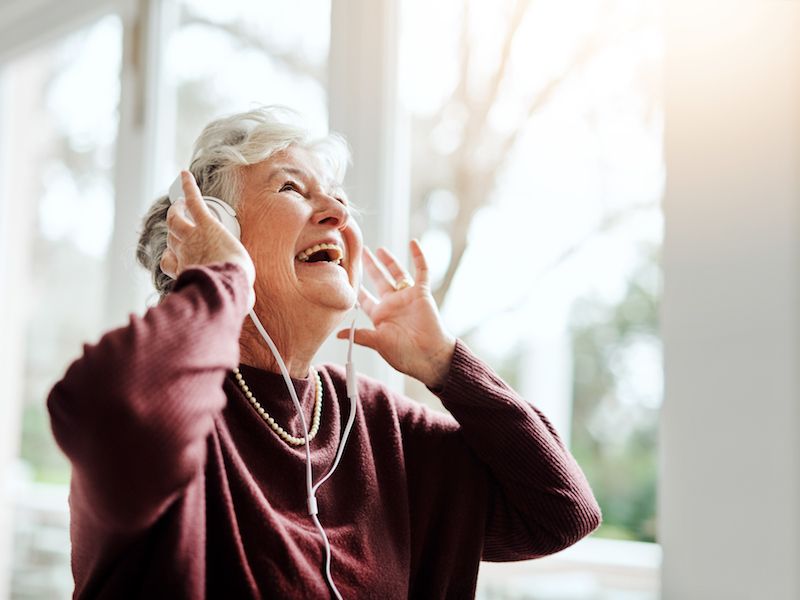
Noise-related loss of hearing doesn’t only impact people who work in loud environments, such as construction workers or heavy metal roadies. It doesn’t even need to be work-related, recreation-related noise exposure can be damaging, also. The most prevalent kind? Loud noise heard through headphones, whether it be gaming, streaming video, music, or even an audiobook with the volume turned up.
You may be surprised to discover that a mobile device can go that loud. The typical pain threshold for human hearing is about 150 db which is in the range of these devices. This is the volume at which noise begins to literally cause pain in your ears. So what’s the plan to safeguard against this sort of noise-related loss of hearing?
It’s relevant here to think about the volume. Listen with the volume at or below 60% for 60 minutes or less each session (how long you listen for also makes a difference), this is called the 60/60 rule.
Your Hearing Aids Can be Set up For Listening to Music
If you have hearing aids, you’re most likely streaming your device directly to your hearing aids, so be certain the volume is not too loud or that you’re not trying to drown out other sounds with your music. Additionally, ask us about how best to listen to music. Hearing aids aren’t made to increase the quality of music like they do with voices so if you’re really into music, you may have noticed this. We may be able to make adjustments to lessen feedback and noise while increasing some frequency ranges to improve the quality of sound while listening to music.
What Are The Right Headphones For You?
When purchasing headphones there are numerous options, especially if you have hearing aids. There are various things to consider, even though it’s largely a matter of personal choice.
Over-the-Ear Headphones
Over the ear headphones are becoming popular again but you most likely won’t see the old foam covered ear pieces that once came with a walkman. They have lots of options in style and color, are usually endorsed by celebrities, and can be unexpectedly expensive. And these headphones cover the entire ear limiting unwanted sound, unlike those old foam ones.
Main-stream wisdom is that these are less dangerous than in-ear headphones because the source of the sound is further from your eardrum. But because the speakers are larger they are usually capable of much higher volume. Noise cancellation can be a helpful thing as long as you’re not missing useful sounds like an oncoming car. Having said that, because they cancel out outside sound, you can often reduce the volume of what you’re listening to so it’s not so loud that it will hurt your hearing.
Earbuds
The standard earbuds that come with devices such as iPhones are much maligned for their inferior quality of sound, but because they come with your phone lots of people still use them. Moreover, with newer models that lack a headphone jack, sticking with Apple’s earbuds can just be easier.
Earbuds also don’t block out noise so the downside is, you tend to turn up the volume. Once again,, though it’s commonly said that earbuds are problematic because you stick them in your ear so their speakers are very close to your eardrum, actually volume is the biggest issue.
Occluding or Isolating Earbuds
More comfortable than standard earbuds, models that have a round rubber tip are the choice of many because they help stop outside sound. A seal that stops outside sound from entering is formed by the rubber tip which molds to the shape of the ear. But these earbuds can also block out sounds you need to hear and loud volume is still the primary issue. And if you wear hearing aids, obviously these won’t work for you.
Several pairs might need to be evaluated before you find headphones that are what you are looking for. Depending on what you’re most often using them for talking on the phone, say, as opposed to listening to music, you’ll have different acoustic requirements. Enjoying your music at a safe volume and coming across headphones that assist you in doing that is essential.
Don’t Cut Corners When it Comes to Your Hearing
Is it Safe, How Can I be Sure? There’s an app for that…If you use a smartphone, you can get the National Institute for Occupational Safety and Health’s free Sound Level Meter app. You can get other apps, but studies has discovered that the dependability of these other apps is hit-and-miss (also, for whatever reason, Android-based apps have proven to be less precise). That motivated NIOSH to develop their own app. The app allows you to measure external sounds, but you can also measure the sound coming from your device’s speakers, essentially, the actual volume of what’s going to your ears. You have to put in a little effort, but taking these kinds of protective steps can help protect your hearing.

